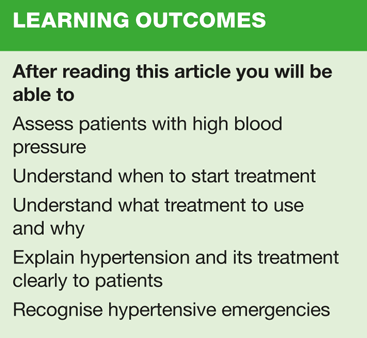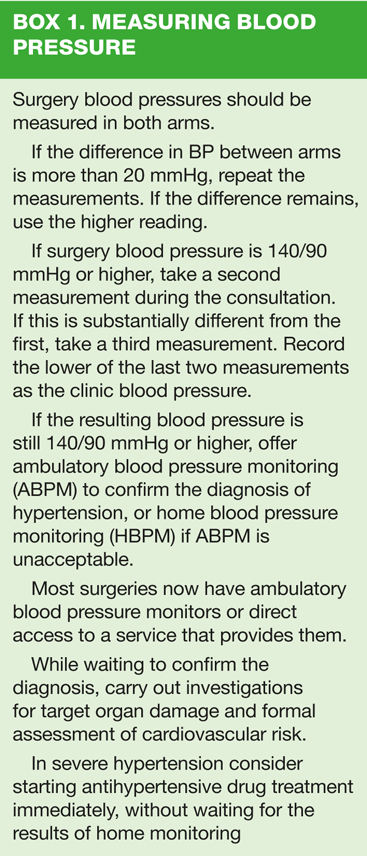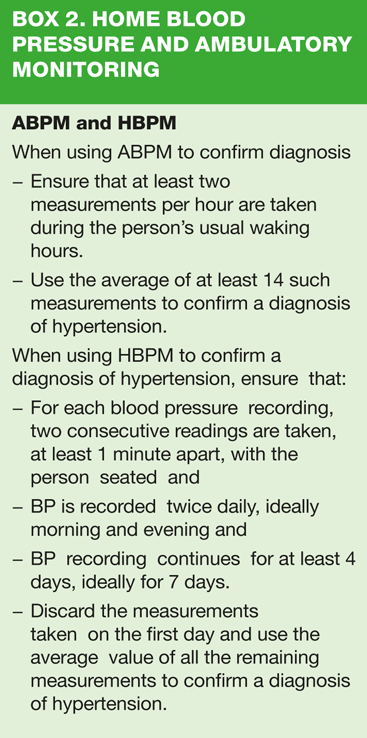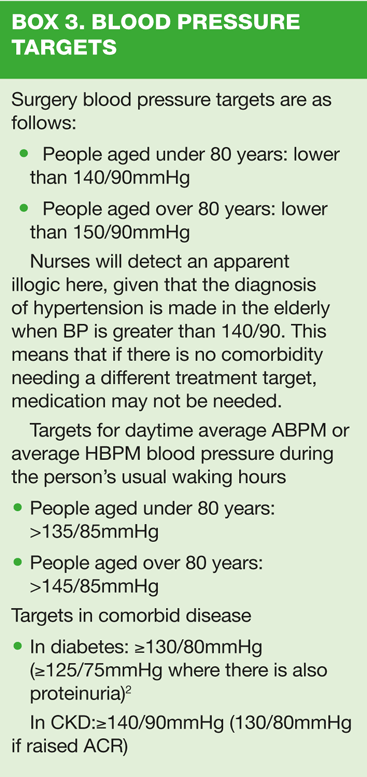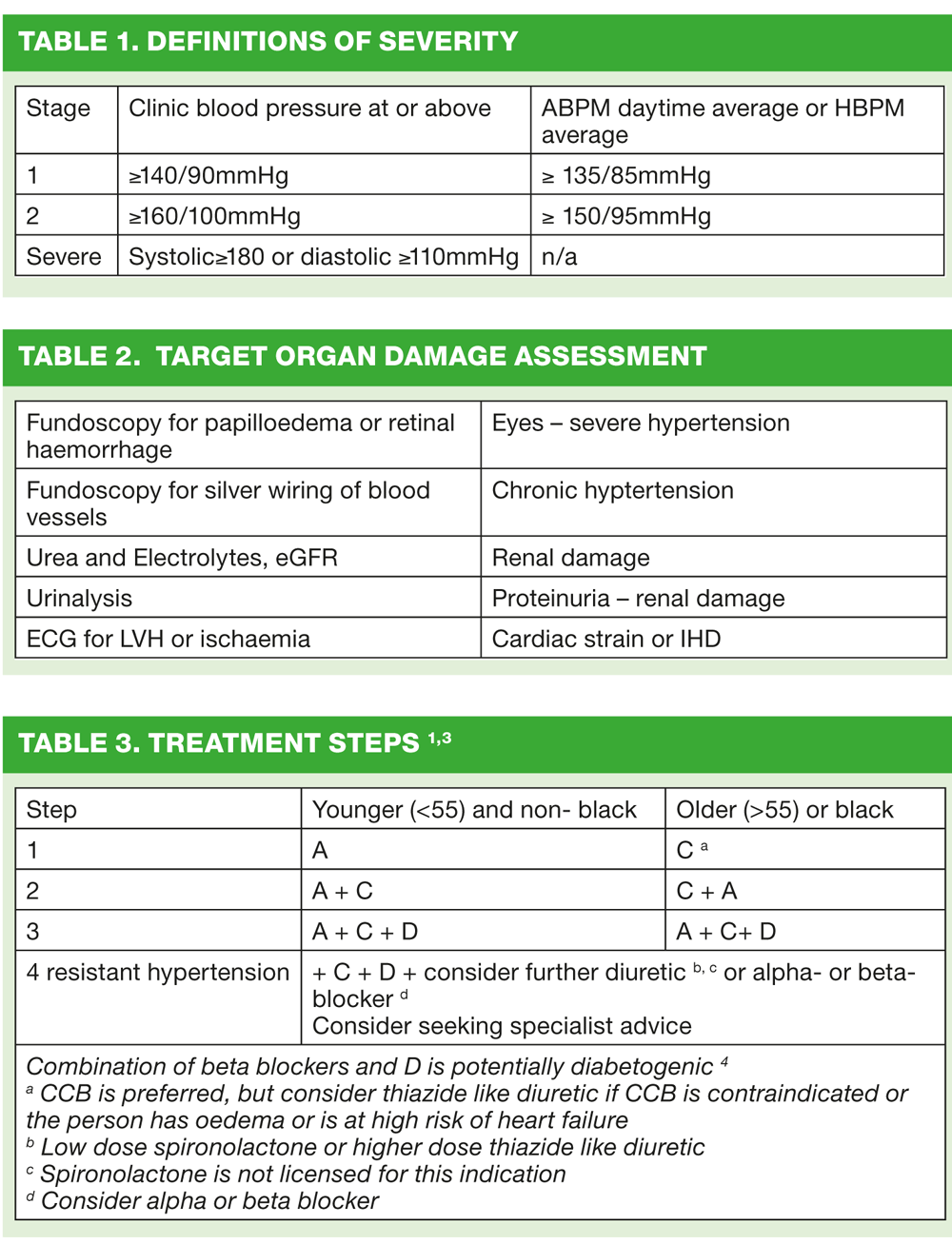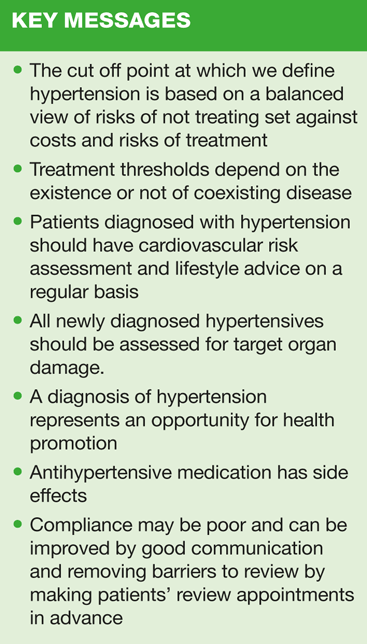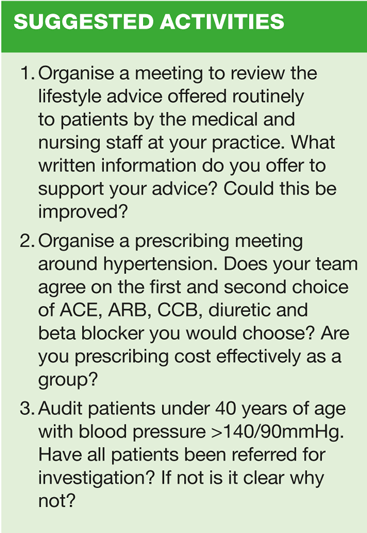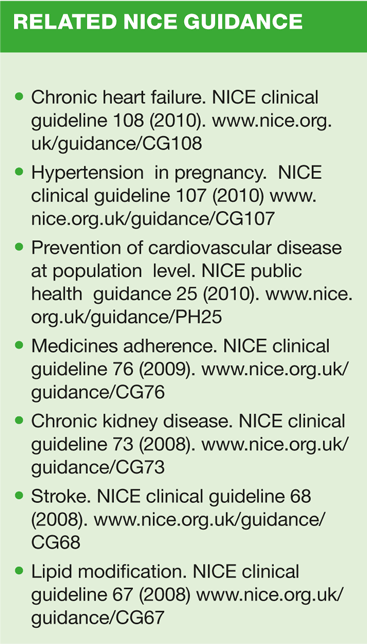Hypertension for the practice nurse
Dr Mary Lowth MA MB BChir FRCGP DRCOG DFFPGP and MRCGP Examiner
Dr Mary Lowth MA MB BChir FRCGP DRCOG DFFPGP and MRCGP Examiner
What is hypertension, and why do we treat it? Practice Nurse reviews the latest NICE guideline, focusing particularly on prescribing choices, and on the rationale behind what we do
Despite the publication of the updated NICE guideline on hypertension in 2011 (CG127), which sets out clear guidance for the management of hypertension in primary care, confusion remains both among health care professionals and among patients, not only about best management but also about what the condition is and why we treat it at all.
WHAT IS HYPERTENSION?
Patients will often ask this simple question and it's important to have a clear explanation. We all have blood pressure. But some people's is higher than others, and some people's is considered higher than is ideal. This is hypertension.
Blood pressure is a measure of the hydrostatic pressure in the arterial system - systolic pressure is the maximum pressure achieved during the systolic pulse, and diastolic pressure is the minimum to which the system relaxes between heartbeats. Clearly we need some pressure in the system for it to fulfill its function of oxygenating the body and brain.
The higher the blood pressure (BP), the greater the long term risk to health. The level at which we treat BP to lower it varies depending on the patient's own level of risk from cormorbidities. Thus patients with diabetes or kidney disease have their blood pressure controlled to lower levels than patients with no coexisting diseases. However, patients are generally considered to have hypertension if their BP lies around the figure of 140/90mmHg.
WHY DOES IT MATTER?
Hypertension is a risk factor for ischaemic and haemorrhagic stroke, myocardial infarction, heart failure, chronic kidney disease, cognitive decline and premature death. Moreover, untreated hypertension tends to worsen with time, and may become treatment resistant. The higher the pressure, the greater the gradual damage to the arterial wall and the kidneys in particular.
The risks associated with raised blood pressure increase continuously. Each 2mmHg rise in systolic blood pressure is associated with a 7% increase in the risk of mortality from ischaemic heart disease, and a 10% increase in that from stroke. This means there is no cut off point at which the risk suddenly rises, so our treatment guidance involves 'cut-off' points for treatment after taking a balanced view of the risk versus the cost, side effects and inconvenience of treatment.
WHO HAS HYPERTENSION?
At least one quarter of adults, and more than half of those over 60, have high blood pressure.1 Management of hypertension is one of the most common interventions in primary care.
Because BP tends to increase with age, some of the highest, most treatment-resistant blood pressures (particularly systolic blood pressures) are found in elderly patients, who may also be more prone to side effects. In people younger than 50 years, elevated diastolic blood pressure is more common.
Occasional high blood pressure
Sometimes we see a patient whose blood pressure is temporarily high for reasons we can explain - but when we recheck it it's completely normal. Many things put blood pressure up acutely - including pain, anxiety, exercise and stress. Reactive rises in blood pressure which then settle to an acceptable normal do not need treatment, although patients may need an annual check as some of those who put their blood pressure up easily in response to stress will ultimately develop chronic elevation. However, the incidental finding of elevated BP in a usually normotensive individual who is very anxious or suffering, for example, a bad migraine, should not prompt immediate treatment unless the blood pressure is at a malignant level.
What is normal?
BP increases with size (both weight and height), and often with age. We all inherit a genetic predisposition to a certain baseline blood pressure, and then the way we live - diet, smoking, exercise and stress - also affect the final result.
Blood pressure will tend to be increased by smoking, stress, excessive alcohol, caffeine and salt intake, weight gain, and lack of exercise.
Conversely, it will tend to be reduced by regular exercise, relaxation, weight loss and - possibly - a moderate intake of alcohol.
DIAGNOSING HYPERTENSION
It is important that a diagnosis of hypertension, which may then result in lifelong treatment, is not made lightly. Guidance on measuring BP in the surgery is summarized in Box 1.
White coat hypertension
Some patients put up their blood pressure at the very presence of a health care professional. You may actually find you have a feel for such patients - they will often tell you they feel anxious, and may have a bounding, fast pulse.
White coat hypertension is defined as a discrepancy of more than 20/10mmHg between surgery readings and average home readings. Of course the patient may still be hypertensive and require treatment, but the home reading average is a better reflection of their usual state than the clinic reading, and should be treated as such.
NICE recommends that white coat hypertension is excluded through ambulatory blood pressure monitoring or, if the patient cannot tolerate this, home readings by the patient. (Box 2)
Urgent referral
Refer people to specialist care the same day if they have:
- accelerated hypertension (blood pressure higher than 180/110 mmHg with signs of papilloedema and/or retinal haemorrhage) or
- suspected phaeochromocytoma (a rare adrenal tumour which causes highly labile blood pressure with extremely high readings , headaches, sweating and palpitations).
WHO TO TREAT?
NICE defines treatment by disease stage (Table 1) and treatment is prescribed in a stepwise progression, according to severity and response.1 BP targets are shown in Box 3.
In stage 1 hypertension
- Treat all patients under 80 who have target organ damage (see Table 2)
- Established cardiovascular disease
- Renal disease
- Diabetes
- Ten year risk 20% or more
In stage 2 hypertension
- Treatment is offered to all patients
In patients under 40 years with stage 1 hypertension but no indication for treatment, the 10-year risk assessment may underestimate their lifetime risk as they have more years to live. Consider seeking specialist evaluation for secondary causes of hypertension and a more detailed assessment of potential target organ damage.
What else to ask or examine
For the practice nurse, these consultations offer the chance to review patients who may not otherwise attend. Consider also examining the patient in respect of conditions that may relate to hypertension:
- Signs of hyperlipidemia (arcus, xanthelasma) - do fasting lipids for assessment of cardiovascular risk
- Distal pulses for peripheral vascular disease
- Abdomen for aortic aneurysm
- Urine for glucose (diabetes)
- BMI to enable discussion of lifestyle issues
- Snoring and sleep apnoea (associated with hypertension)
- Erectile dysfunction (remember beta blockers can cause or worsen this)
If the BP is not raised remind the patient to return in five years for another reading
TREATMENT STEPS
Secondary hypertension may be due to renal or endocrine disease5 or to other, rare causes such as porphyria and lead poisoning.
Treatment choices
NICE2 gives clear guidance on drug treatment, laid out in Table 3. Your locality may have a preferred ACE inhibitor, CCB and statin, but the principles of treatment remain the same.
Step 1
- For people aged under 55 an ACE inhibitor or low-cost ARB. If an ACE inhibitor is not tolerated offer a low-cost ARB.
- People over 55 years and people of African or Caribbean origin of any age use a calcium-channel blocker (CCB). If a CCB is not suitable, for example because of high risk of heart failure, use a thiazide-like diuretic such as chlortalidone or indapamide in preference to a conventional thiazide diuretic such as bendroflumethiazide or hydrochlorothiazide.
- For people who are already on bendroflumethiazide or hydrochlorothiazide with stable, well controlled BP there is no need to change.
- Beta-blockers may be considered for younger people if ACE inhibitors and ARBs are contraindicated or not tolerated or there is evidence of increased sympathetic drive, and for women of child-bearing potential.
- If blood pressure is not controlled by step 1 treatment, offer step 2 treatment.
Step 2
- Use CCB in combination with ACE inhibitor or ARB
- If a CCB is not suitable, use a thiazide-like diuretic.
- For people of Afro-Caribbean origin, use an ARB in preference to an ACEi, in combination with a CCB.
- If a beta-blocker was used in step 1, add a CCB rather than thiazide diuretic, to reduce the risk of diabetes.
- Before initiating step 3, ensure step 2 treatment is at optimal or best tolerated doses.
Step 3
- Offer ACEi/ARB with CCB and thiazide-like diuretic.
- Regard blood pressure that remains >=140/90mmHg after step 3 treatment with best tolerated doses as resistant hypertension: consider step 4 or seeking expert advice.
Step 4
- Further diuretic therapy with low-dose spironolactone if blood potassium level is <=4.5 mmol/l. Use caution in people with reduced eGFR, who have increased risk of hyperkalaemia.
- Alternatively use a higher-dose thiazide-like diuretic if blood potassium level is >4.5 mmol/l.
- Check U&Es and eGFR within 1 month.
- If further diuretic therapy is not tolerated, or is contraindicated or ineffective, consider an alpha- or beta-blocker.
- If blood pressure remains uncontrolled with four drugs seek expert advice if this has not yet been obtained.
START LOW
Patients should be started on a low dose with monitoring of their response to treatment at intervals of no less than 2 weeks. Warn about potential side effects, particularly postural hypotension early on with ACE inhibitors, and ankle swelling and headaches with CCBs.
The general principles to follow are
- Offer once daily drugs where possible
- Prescribe generically
- Treat isolated systolic hypertension in the same way as if the diastolic BP is also raised
- Treat the over 80s with the same medicines as the over 55s
- Do not combine ACE with ARB
- When prescribing in women of childbearing age, consider pregnancy
LIFESTYLE MANAGEMENT
The diagnosis of hypertension offers us a huge opportunity to offer constructive lifestyle advice, which may impact on far more than just the hypertension. For many patients this may be the first time they have needed regular medication and indeed the first time anything has been 'wrong' with them. They may feel perfectly well. So it may be a wake-up call.
We should routinely cover:
- diet and exercise, reviewing BMI and exercise levels and offering guidance to promote lifestyle changes
- alcohol consumption - suggest cutting down if they drink more than the recommended number of units (3-4 per day for men, and 2-3 per day for women)
- caffeine and salt consumption - reviewing high intake
- local initiatives (for example, run by healthcare teams or local sports centres) that provide support and promote lifestyle change
- relaxation therapies can be helpful although they are not offered in primary care
MONITORING AND TREATMENT TARGETS
Patients with primary hypertension and no other coexisting illnesses needing more frequent review, need their BP reviewed at least annually once stable. However while achieving BP control warn the patient that they will need to attend several times in order to make sure treatment is optimised and side effects are acceptable or absent. This can be quit a commitment for working patients and it can be helpful to book advance appointments for them, if your system allows it.
Use surgery blood pressure measurement to monitor the response to treatment, although use ABPM or HBPM as an adjunct to clinic blood pressure measurements in those who have demonstrated a white coat effect.
SUMMARY
Hypertension is a chronic condition in which the hydrostatic pressure in the arterial system is, on average, at a higher level than desirable. It is not a disease in itself but a risk factor for disease. Treatment is therefore a long-term approach to reducing risk, involving a series of therapeutic steps according to severity and response.
For the practice nurse hypertension represents not only the chance to gain valuable therapeutic experience but also a huge opportunity to address patients' lifestyles, to screen selectively for related diseases and conditions, to assist in the attainment of QoF targets and to educate the rest of the team in consistency and best practice.
KNOWLEDGE CHECKER
1.What is the target blood pressure when treating hypertensive patients under 80 years old?
140/90mmHg if there are no coexisting conditions which might point to a lower target
2. What is the difference between ABPM and HBPM?
ABPM involves the patient wearing a battery-powered sphygmomanometer, which automatically inflates at intervals throughout the day, thus obtaining an average blood pressure reading over a prolonged period. Some patients find it uncomfortable or intrusive but it offers the closest approximation of the true picture that we can obtain easily. HBPM involves the patient taking and recording his or her own blood pressure, twice daily (two readings each time) over a period of, ideally, 7-10 days.
3. What signs and symptoms should lead to on the day referral for severe hypertension?
BP over 180/110mmHg with retinal haemorrhage, papilloedema or suspicion of phaeochromocytoma
4. What is the preferred first and second line antihypertensive medication in an Afro-Caribbean patient?
A calcium channel blocker is the preferred first line option with an ARB as second line.
5. What can you do to aid patient compliance with management?
Explain the nature of hypertension and the reason for treatment. Start with small doses of once a day medication and warn patients firstly about side effects but secondly that it will take several visits before treatment is optimized. Book appointments ahead for them at a time they are able to attend and consider telephone or text reminder of the appointment on the day before.
6. What is the purpose of referring patients under 40 years of age with newly diagnosed hypertension for investigation?
There is more chance of finding a secondary cause and they need to be closely investigated for the presence of one. In addition cardiovascular 10-year risk figures are not a true reflection of these patients' lifetime risk of complications.
7. Should women who are planning families and found to be hypertensive be put on medication?
Yes, if they are at stage 2 or stage 1 with complications. Beta blockers are the treatment of choice. Labetalol is considered safe in pregnancy. Such women will need specialist involvement in their antenatal care as their blood pressure is likely to rise in pregnancy and they will need increased monitoring.
8. How do you look for end organ damage in hypertension?
Fundoscopy, renal function tests and eGFR, ECG and urinalysis.
9. What is the target blood pressure for a hypertensive patient found to have diabetes and proteinuria?
125/75- go with the lowest target for the combination of conditions.
10. When is spironolactone used in hypertension?
Spironolactone is not licensed for this indication but is a stage 4 drug used at a low dose in patients whose serum potassium is less than 4.5mmol/l
REFERENCES
1. Hypertension: Clinical management of primary hypertension in adults: http://publications.nice.org.uk/hypertension-cg127
2. Williams B, Poulter NR, Brown MJ, Davis M, McInnes GT, Potter JF, et al. Guidelines for management of hypertension: report of the fourth working party of the British Hypertension Society, 2004 BHS IV. J Hum Hypertens 2004;18: 139-85
3. GPnotebook : ACD combination drug therapy in hypertensive patients : https://www.gpnotebook.co.uk/simplepage.cfm?ID=-1952841657
4. Brown MJ, Cruickshank JK, Dominiczak AF, MacGregor GA, Poulter NR, Russell GI, Thom S, Williams B; Better blood pressure control: how to combine drugs. J. Hum Hypertens 2003 Feb:17(2):81-86 www.ncbi.nlm.nih.gov/pubmed/12574784?dopt=Abstract
5. GPnotebook: Secondary hypertension http://www.gpnotebook.co.uk/simplepage.cfm?ID=798621749&linkID=65209&cook=no&mentor=1
Related articles
View all Articles
